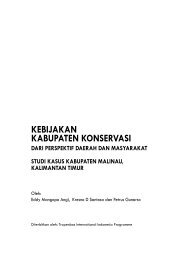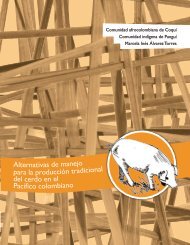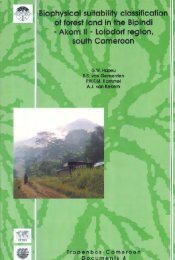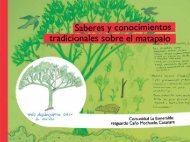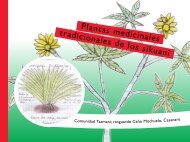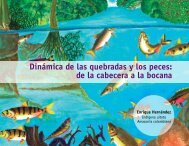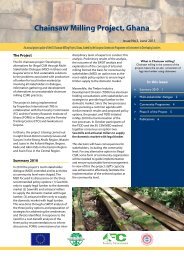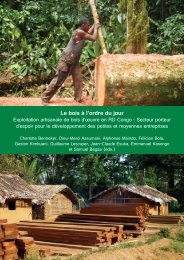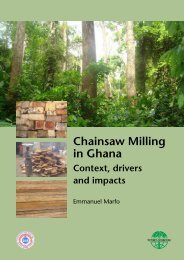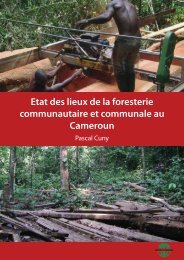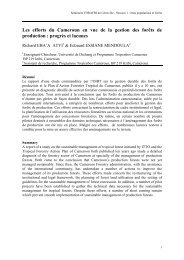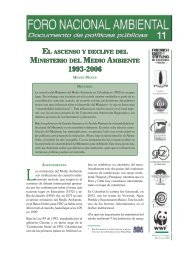Download the publication - Tropenbos International
Download the publication - Tropenbos International
Download the publication - Tropenbos International
Create successful ePaper yourself
Turn your PDF publications into a flip-book with our unique Google optimized e-Paper software.
Plant diversity in a Central African rain forest: Implications for biodiversity conservation in Cameroon<br />
Africa (Hamilton, 1982; White, 1983; Maley, 1987, 1989 & 1990; Sosef, 1994 &<br />
1996). In such refugia, <strong>the</strong> unique combination of climatic and geological histories,<br />
contemporary ecological factors, and inherent biological properties of taxa and <strong>the</strong>ir<br />
combinations, may have contributed to survival and/or speciation (Barbault &<br />
Sastrapradja, 1995; Hawksworth & Kalin-Arroyo, 1995). Fur<strong>the</strong>rmore, <strong>the</strong> Campo-<br />
Ma’an area forms part of <strong>the</strong> Guineo-Congolian Regional Centre of Endemism<br />
(White, 1983). All families endemic to this biogeographic region are found in <strong>the</strong> area<br />
(White, 1983). They include Hoplestigmataceae, Huaceae, Lepidobotryaceae,<br />
Medusandraceae, Pandaceae, Pentadiplandraceae and Scytopetalaceae. Moreover,<br />
82% of endemic genera cited by White (1983) also occur in <strong>the</strong> area. They are<br />
Afrobrunnichia, Amphimas, Anthonotha, Aneulophus, Antrocaryon, Aphanocalyx,<br />
Aubrevillea, Aucoumea, Anopyxis, Baillonella, Brenania, Buchholzia, Calpocalyx,<br />
Coelocaryon, Coula, Crotonogyne, Cylicodiscus, Desbordesia, Didelotia,<br />
Discoglypremna, Distemonanthus, Duboscia, Endodesmia, Erismadelphus, Grossera,<br />
Heckeldora, Hylodendron, Hymenostegia, Hypodaphnis, Gilbertiodendron,<br />
Gossweilerodendron, Loesenera, Monopetalanthus (now synonym of Bikinia),<br />
Ophiobotrys, Pachyelasma, Poga, Tessmannia, Tetraberlinia, Turraeanthus and<br />
Tieghemella.<br />
Forest richness and biodiversity hotspots<br />
The study has demonstrated that <strong>the</strong> submontane forest, <strong>the</strong> lowland evergreen forest<br />
rich in Caesalpinioideae with Calpocalyx heitzii and Sacoglottis gabonensis, and <strong>the</strong><br />
lowland evergreen forest rich in Caesalpinioideae are richer in species of high<br />
conservation priorities compared to <strong>the</strong> o<strong>the</strong>r forest types. This is confirmed by <strong>the</strong><br />
high average GHI scores recorded in <strong>the</strong>se forest types (Figure 5.3). More than 57% of<br />
<strong>the</strong> plots recorded have a high average GHI score (GHI > 150). However, <strong>the</strong> coastal<br />
forest on sandy shorelines and forest rich in Aucoumea klaineana had lower GHI<br />
scores than o<strong>the</strong>rs. There was a strong significant negative correlation between <strong>the</strong><br />
average GHI scores and <strong>the</strong> average PI scores recorded in <strong>the</strong> various vegetation<br />
types. Most of <strong>the</strong> National Park and <strong>the</strong> coastal forests around Massif des Mamelles<br />
and Mont d’Eléphant was characterised by a high conservation value with small<br />
patches of forest with very high conservation value located in <strong>the</strong> submontane forest<br />
on hilltops, in Dipikar Island, on Massif des Mamelles, and Mont d’Elephant. More<br />
often, <strong>the</strong>se forests were virtually undisturbed or less than 25% disturbed (Figure 5.5).<br />
This implies that <strong>the</strong> Massif des Mamelles and <strong>the</strong> Mont d’Elephant areas represent<br />
o<strong>the</strong>r biodiversity hotspots, located outside of <strong>the</strong> Park (Figure 5.7). In <strong>the</strong> contrary,<br />
<strong>the</strong> forests around Campo, agro-industrial plantations, logging concessions, near<br />
villages and along <strong>the</strong> roads had a low conservation value with low GHI scores, high<br />
PI scores and high levels of disturbance. This confirmed that disturbed forests are rich<br />
in pioneer species but poor in plant species with high conservation priority. It is worth<br />
reiterating that a considerable portion of <strong>the</strong> Campo-Ma’an area has been selectively<br />
logged at least twice during <strong>the</strong> past 30 years. Although logging damages were<br />
moderate and had low effect on <strong>the</strong> total forest biodiversity, it has created forest gaps<br />
that allowed <strong>the</strong> development of many pioneer species. This might have contributed to<br />
<strong>the</strong> high average PI scores registered in <strong>the</strong> coastal forest types.<br />
Threatened species<br />
During <strong>the</strong> selection of species of high conservation priority, taxa were chosen on a<br />
global ra<strong>the</strong>r than a Cameroonian or a Campo-Ma’an perspective of conservation<br />
100



